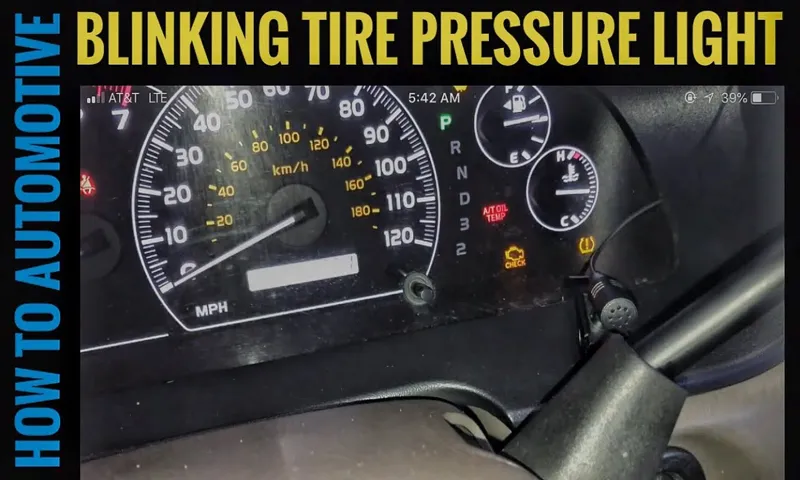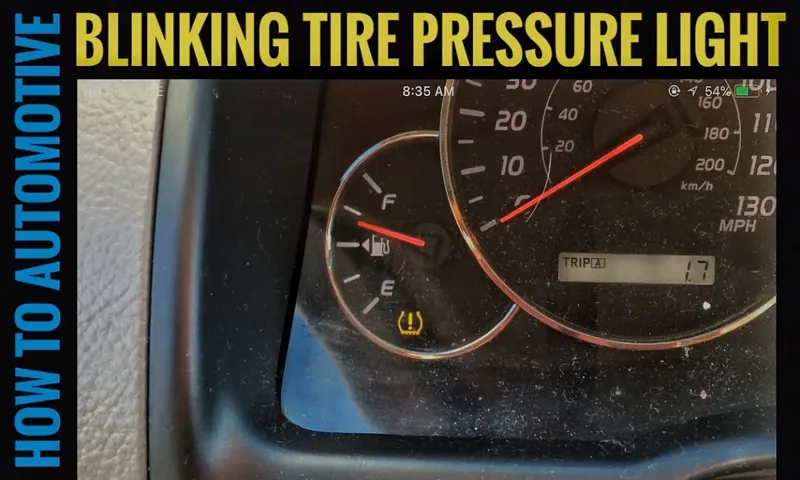You’re driving down the road, and suddenly you notice your tire light is flashing. At first, you may think it’s just a glitch or a random warning sign. But no, it’s indicating a real problem that needs attention.
Whether you’re a seasoned driver or a new one, it’s crucial to understand why your tire light flashes and what it means. In this blog, we’ll explore the different reasons why your tire light might be flashing, what actions you should take to address the issue, and how to avoid it from happening again. So, fasten your seatbelts, and let’s dig in!
Table of Contents
Introduction
Have you ever been driving down the road and suddenly noticed your tire light flashing? It can be a bit unsettling, but don’t worry, it’s not necessarily a cause for alarm. This warning light is there to let you know that something might be wrong with your tires. It could be something as simple as low tire pressure, or it could be signaling a more serious issue like a flat tire or a damaged tire.
Regardless of the cause, it’s important to address the issue quickly and get it resolved before it leads to bigger problems down the road. So, if your tire light is flashing, take it seriously and get it checked out as soon as possible.
Explaining the tire pressure monitoring system
The tire pressure monitoring system, commonly referred to as TPMS, is an essential feature in modern vehicles that ensures proper tire pressure levels are maintained. It is designed to alert the driver of any deviation from the recommended tire pressure levels, which can lead to increased fuel consumption, tire wear, and even accidents in some cases. The system is equipped with sensors installed in the tire, which transmit data to the car’s computer system, where it is analyzed, and the driver is alerted in case of any deviations from the recommended tire pressure levels.
Maintaining proper tire pressure levels using the TPMS system not only ensures optimum vehicle performance but also promotes fuel efficiency, saves on costs, and improves overall safety on the road.

Why the tire light flashes
If you’ve ever had your tire light flash on and wondered what’s causing it, you’re not alone. Many drivers experience this issue, and it can be a bit concerning. Typically when the tire light flashes, it indicates that there is a problem with the tire pressure monitoring system (TPMS).
The TPMS is designed to alert you when your tire pressure drops below a certain level, which can happen for a variety of reasons. Sometimes it’s due to a leaky valve stem, slow leaks, or punctures, while other times, it’s just a matter of the temperature dropping, causing the air inside the tire to contract. Regardless of the cause, it’s important to get your TPMS checked out if the tire light continues to flash even after you’ve adjusted your tire pressure.
This will ensure that your tires remain safe and that you avoid any potential blowouts or dangerous driving conditions.
How to stop the flashing
As we spend more of our time using digital devices, the constant blinking and flashing of screens can become irritating and even harmful to our eyes. Fortunately, there are ways to reduce or even eliminate screen flicker. One option is to adjust the refresh rate of your monitor.
This can be done through your computer’s display settings, and increasing the refresh rate can often reduce flickering. Another option is to use software that can reduce blue light emissions, which can also help to reduce flicker and ease eye strain. Finally, taking regular breaks and giving your eyes a rest from screens can make a big difference in reducing flicker-related discomfort.
With these simple steps, you can say goodbye to screen flicker and enjoy a more comfortable, eye-friendly digital experience.
Causes of the flashing tire light
If you notice that your tire light is flashing, it could be an indication of an issue with the tire pressure monitoring system (TPMS). This system is designed to notify you if there is low tire pressure or a puncture in one of your tires. When the TPMS detects an issue, it sends a signal to your car’s computer, triggering the flashing tire light.
Low tire pressure is a common cause of the flashing tire light, often due to changes in temperature or slow leaks. However, it’s also possible that the TPMS sensor has malfunctioned, the battery in the sensor needs replacing, or there is an issue with the valve stem or wheel. It’s best to check your tire pressure and visually inspect your tires if the flashing tire light is present.
If you’re unsure about the cause or need further assistance, it’s important to seek the help of a professional mechanic.
Low tire pressure
Low tire pressure is one of the most common causes of the flashing tire light on your vehicle. This warning light is designed to alert you to any significant changes in tire pressure, and low pressure can cause serious problems while driving. Some of the most common causes of low tire pressure include a punctured or damaged tire, poor tire maintenance or underinflation.
If you notice the tire light flashing, it’s important to check your tire pressure as soon as possible to prevent any further damage or potential accidents. Regular tire inspections and maintenance can help prevent low tire pressure and keep you safely on the road. So, if you notice the tire light flashing, don’t wait – check your tire pressure and inflate your tires to the proper levels to ensure your safety on the road.
Tire puncture
If you’re driving and suddenly see the tire pressure light flashing on your dashboard, it’s a sure sign that something is wrong with your tires. One of the most common causes of this issue is a tire puncture or leak. Even a small puncture can cause air to escape from the tire, which can eventually lead to a flat if not addressed.
Other causes of tire punctures can include road debris, nails, or screws. It’s important to get a puncture repaired as soon as possible, as driving on a flat can be dangerous and damaging to your vehicle. If you’re experiencing a flashing tire light, make sure to check your tires for any signs of punctures or leaks.
And remember, prevention is key – periodically checking your tires for damage or wear can help you avoid these issues in the first place.
Faulty tire pressure sensors
If you’ve ever experienced a flashing tire light on your car, one possible culprit could be faulty tire pressure sensors. These sensors are responsible for monitoring the air pressure in your tires and sending a signal to your car’s computer system. If the pressure in a tire is too low or too high, the sensor will trigger the flashing tire light on your dashboard.
However, sometimes these sensors can malfunction and send false signals, causing the flashing tire light to turn on even when there’s no real issue with your tires. In this scenario, it’s best to have the sensors checked and replaced if necessary by a qualified mechanic.
How to fix the issue
If you see a flashing tire light on your dashboard, it could mean there is an issue with your tire pressure monitoring system. First, check the air pressure in all four tires and adjust as necessary. If the light continues to flash, it may indicate a faulty sensor or wiring related to the monitoring system.
It’s best to have your vehicle checked by a professional mechanic to identify and resolve the problem. Ignoring the flashing tire light could lead to unsafe driving conditions or damage to your tires. Stay safe on the road and prioritize inspecting your vehicle when you notice any unusual warning signals, including a flashing tire light.
Checking tire pressure
Maintaining proper tire pressure is essential for optimal vehicle performance, fuel efficiency, and safety. It’s recommended that you check your tire pressure at least once a month and before long trips. To fix the issue of low tire pressure, start by checking your vehicle’s manual for the recommended tire pressure and use a tire pressure gauge to check each tire’s pressure.
If you find one or more tires that are underinflated, use an air compressor or visit a gas station with an air pump to fill the tires to the proper pressure. Overinflated tires can also cause issues, so make sure not to exceed the recommended pressure. Keeping your tires properly inflated can improve your vehicle’s handling, reduce wear and tear, and potentially prevent accidents.
Remember, a few minutes spent checking your tire pressure could save you from costly repair bills and dangerous situations on the road.
Inflating or replacing the tire
Inflating or replacing the tire is a common issue that many of us face with our vehicles. If you notice that your tire is flat, the first thing you should do is visually inspect it for any damage or punctures. If you find any, it may be necessary to replace the tire entirely.
However, if there is no visible damage, inflating the tire may be all that is needed. To do so, you will need a tire gauge and an air compressor. Check the recommended tire pressure listed in your vehicle’s owner’s manual and inflate the tire accordingly.
If the tire continues to lose air, there may be a leak in the stem or valve, which will require replacement. Regardless of whether you need to inflate or replace the tire, it is important to address the issue as soon as possible to avoid further damage or potential accidents.
Resetting the tire pressure monitoring system
Resetting the tire pressure monitoring system can be a bit of a hassle, but it’s important to do so to ensure that your vehicle is safe to drive. The first step is to locate the TPMS reset button, which is usually found under the steering wheel or on the dashboard. Once you’ve located it, turn on the ignition and press and hold the reset button until the TPMS light flashes.
This may take up to a few minutes, so don’t panic if it doesn’t happen right away. Once the light stops flashing, start your vehicle and make sure the TPMS light has turned off. If it hasn’t turned off, it may be necessary to take your vehicle to a mechanic to have it checked out.
It’s also important to remember that the TPMS only monitors tire pressure, not tread depth or other tire issues. So, be sure to regularly check your tires for wear and tear, as well as ensuring they are properly inflated. By taking these steps, you can ensure the safety of yourself and others on the road.
Conclusion
When your tire light is flashing, it’s like a tiny beacon trying to tell you something important: your tires are not feeling their best and could use some attention. It’s like your car is whispering to you, ‘hey buddy, it’s time to give my feet a little care and make sure we’re both safe on the road.’ So be kind to your car and take care of those tires.
After all, they’re the only thing keeping you and your trusty ride rolling down the road.”
FAQs
What does it mean when my tire light is flashing?
Your tire light flashing could indicate low pressure in your tires, a punctured tire, or a malfunction with the tire pressure sensor. Check your tire pressure and inspect your tires for any visible damage.
How often should I check my tire pressure?
It is recommended to check your tire pressure at least once a month, or before a long trip. This helps to ensure optimal fuel efficiency and safety.
What is the proper tire pressure for my vehicle?
The recommended tire pressure for your vehicle can typically be found in the owner’s manual or on a sticker located inside the driver’s side door jamb. It can vary depending on the make and model of the vehicle.
Can I still drive with my tire light flashing?
It is not recommended to continue driving with a flashing tire light, as it could indicate a serious issue with your tires. It is best to check the tire pressure and address any issues before driving again.
Why do tire pressure sensors malfunction?
Tire pressure sensors can malfunction due to a variety of reasons, including low battery life, corrosion or damage to the sensor, or interference from electronic devices.
How can I prevent tire pressure sensor malfunctions?
Regularly checking and maintaining proper tire pressure can help prevent sensor malfunctions. Additionally, avoiding harsh impacts on your tires and keeping electronics away from the sensors can also help.
Should I replace my tire pressure sensors if they malfunction?
If your tire pressure sensors are malfunctioning, it is recommended to have them inspected by a professional mechanic. They may need to be replaced, but it will depend on the severity of the issue.



